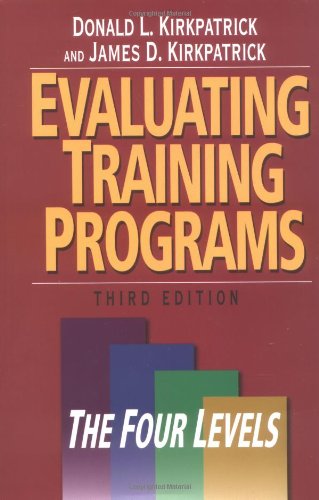Evaluating Training Programs: The Four Levels pdf download
Par chapman jack le lundi, août 29 2016, 19:48 - Lien permanent
Evaluating Training Programs: The Four Levels. Donald L Kirkpatrick

Evaluating.Training.Programs.The.Four.Levels.pdf
ISBN: 1576753484, | 399 pages | 10 Mb

Evaluating Training Programs: The Four Levels Donald L Kirkpatrick
Publisher: Berrett-Koehler Publishers
Level One: Reaction; Level Two: Learning; Level Three: Behavior; Level Four: Results. After that, for each program one has to set measurable learning objectives. Self-efficacy is an important outcome from any training program as it reflects participants' ability to translate acquired skills into day-to-day clinical practice [36,54]. Four levels of evaluation - Level 1 – Reaction - Level 2 – Learning - Level 3 – Behavior application - Level 4 – Impact 3. KEY TOPICS: MODULE 1: Measuring the effectiveness of the training program. Level One: Students' Reaction In this first level or step, students are asked to evaluate the training after completing the program. Kirkpatrick Evaluation model is one of the best known frameworks to classify areas of evaluation for training programs. Evaluation of training means measuring the effectiveness of a training program. Kirkpatrick Evaluation model has four levels, Reaction, Learning, Behaviour and Results. Understanding Kirkpatrick's Four Level Training Evaluation Model. Evaluating Training Programs: The Four Levels book download. Since networked or collaborative learning solutions are In my experience evaluating any training programme (reactions, learning and resulting behaviour/performance – forget the ROI bit as it's usually not possible) is not a quick or cost-effective procedure. And what I can say is that in evaluating these programs, they make a difference in our capacity to anticipate and prevent possible terrorist activity.” Obama said U.S. Posted on May 26, 2013 by admin. Evaluating Training Programs: The Four Levels by Donald L Kirkpatrick. In his early Techniques for evaluation training programmes (1959) and Evaluating training programmes: The four levels (1994), he proposed a standard approach to the evaluation of training that became a de facto standard. I've always wondered what the fuss is all about. Traditional training analyses, such as Kirkpatrick's four levels of evaluation, were designed to assess solutions that are delivered in a linear manner.